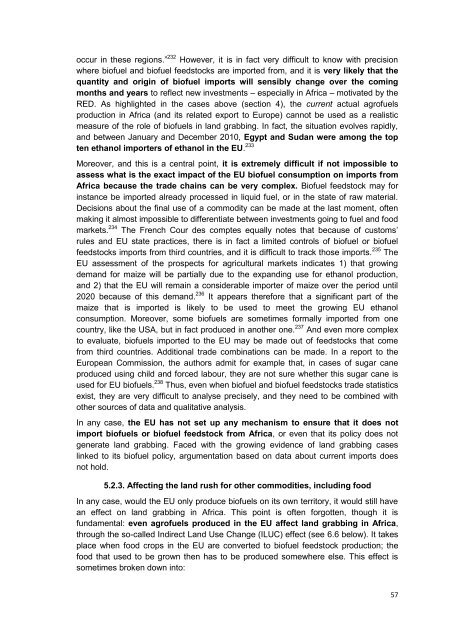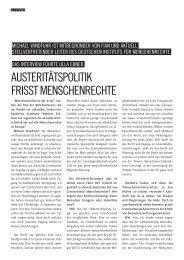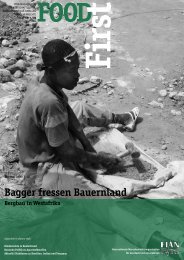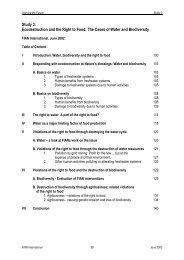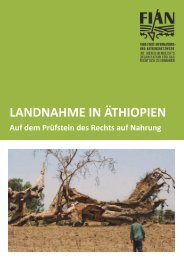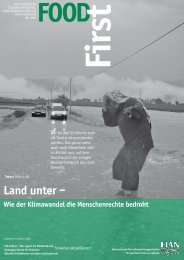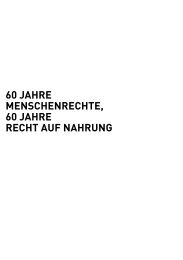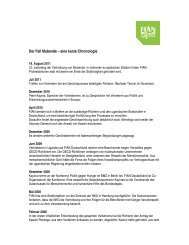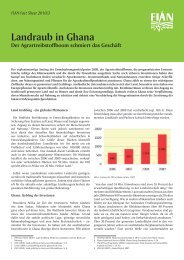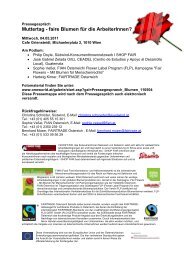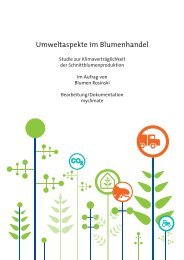(Bio)Fueling Injustice? - Europafrica
(Bio)Fueling Injustice? - Europafrica
(Bio)Fueling Injustice? - Europafrica
Create successful ePaper yourself
Turn your PDF publications into a flip-book with our unique Google optimized e-Paper software.
occur in these regions.” 232 However, it is in fact very difficult to know with precision<br />
where biofuel and biofuel feedstocks are imported from, and it is very likely that the<br />
quantity and origin of biofuel imports will sensibly change over the coming<br />
months and years to reflect new investments – especially in Africa – motivated by the<br />
RED. As highlighted in the cases above (section 4), the current actual agrofuels<br />
production in Africa (and its related export to Europe) cannot be used as a realistic<br />
measure of the role of biofuels in land grabbing. In fact, the situation evolves rapidly,<br />
and between January and December 2010, Egypt and Sudan were among the top<br />
ten ethanol importers of ethanol in the EU. 233<br />
Moreover, and this is a central point, it is extremely difficult if not impossible to<br />
assess what is the exact impact of the EU biofuel consumption on imports from<br />
Africa because the trade chains can be very complex. <strong>Bio</strong>fuel feedstock may for<br />
instance be imported already processed in liquid fuel, or in the state of raw material.<br />
Decisions about the final use of a commodity can be made at the last moment, often<br />
making it almost impossible to differentiate between investments going to fuel and food<br />
markets. 234 The French Cour des comptes equally notes that because of customs’<br />
rules and EU state practices, there is in fact a limited controls of biofuel or biofuel<br />
feedstocks imports from third countries, and it is difficult to track those imports. 235 The<br />
EU assessment of the prospects for agricultural markets indicates 1) that growing<br />
demand for maize will be partially due to the expanding use for ethanol production,<br />
and 2) that the EU will remain a considerable importer of maize over the period until<br />
2020 because of this demand. 236 It appears therefore that a significant part of the<br />
maize that is imported is likely to be used to meet the growing EU ethanol<br />
consumption. Moreover, some biofuels are sometimes formally imported from one<br />
country, like the USA, but in fact produced in another one. 237 And even more complex<br />
to evaluate, biofuels imported to the EU may be made out of feedstocks that come<br />
from third countries. Additional trade combinations can be made. In a report to the<br />
European Commission, the authors admit for example that, in cases of sugar cane<br />
produced using child and forced labour, they are not sure whether this sugar cane is<br />
used for EU biofuels. 238 Thus, even when biofuel and biofuel feedstocks trade statistics<br />
exist, they are very difficult to analyse precisely, and they need to be combined with<br />
other sources of data and qualitative analysis.<br />
In any case, the EU has not set up any mechanism to ensure that it does not<br />
import biofuels or biofuel feedstock from Africa, or even that its policy does not<br />
generate land grabbing. Faced with the growing evidence of land grabbing cases<br />
linked to its biofuel policy, argumentation based on data about current imports does<br />
not hold.<br />
5.2.3. Affecting the land rush for other commodities, including food<br />
In any case, would the EU only produce biofuels on its own territory, it would still have<br />
an effect on land grabbing in Africa. This point is often forgotten, though it is<br />
fundamental: even agrofuels produced in the EU affect land grabbing in Africa,<br />
through the so-called Indirect Land Use Change (ILUC) effect (see 6.6 below). It takes<br />
place when food crops in the EU are converted to biofuel feedstock production; the<br />
food that used to be grown then has to be produced somewhere else. This effect is<br />
sometimes broken down into:<br />
57


